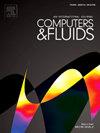From simplex to mixed element: Extension of a vertex-centered discretization, focus on accuracy analysis and 3D RANS applications
IF 2.5
3区 工程技术
Q3 COMPUTER SCIENCE, INTERDISCIPLINARY APPLICATIONS
引用次数: 0
Abstract
Standard unstructured-grid CFD simulations generally rely on a cell-centered Finite Volume discretization applied to mixed-element grids. The interest in such approach is using elements that are aligned along a privileged direction in the region close to the boundary, and at the same time unstructured elements near complex geometrical details or in farfield regions. This paper proposes a novel version of the mixed Finite Element/Finite Volume approximation (Debiez and Dervieux 2000), which is a vertex-centered method known to produce second-order accurate solutions even on highly anisotropic adapted meshes composed of simplex elements (i.e., triangles and tetrahedra) (Alauzet and Loseille, 2010; Barral et al., 2017; Alauzet et al., 2018; Belme et al., 2019). The extension of this approach for two-dimensional mixed-element meshes was proposed in Tarsia Morisco et al. (2024) and involves the APproximated Finite Element -APFE- method (Puigt et al., 2010) to discretize diffusion. In this work we make the definitive step forward to handle three-dimensional mixed-element meshes: designing a second-order accurate scheme for smooth meshes involving tetrahedra, prisms and pyramids.
The present work focuses on two key aspects. One concerns the 3D extension of the APFE method. A detailed error analysis of this vertex-centered approach is provided for prisms and pyramids. The second ingredient deals with an innovative algorithm to compute the truncation error for linear problems. In contrast to usual methods, the one proposed here permits to compute exactly the coefficients related to each terms of error for any mesh, and can be implemented in any solver with a low development effort.
求助全文
约1分钟内获得全文
求助全文
来源期刊

Computers & Fluids
物理-计算机:跨学科应用
CiteScore
5.30
自引率
7.10%
发文量
242
审稿时长
10.8 months
期刊介绍:
Computers & Fluids is multidisciplinary. The term ''fluid'' is interpreted in the broadest sense. Hydro- and aerodynamics, high-speed and physical gas dynamics, turbulence and flow stability, multiphase flow, rheology, tribology and fluid-structure interaction are all of interest, provided that computer technique plays a significant role in the associated studies or design methodology.
 求助内容:
求助内容: 应助结果提醒方式:
应助结果提醒方式:


